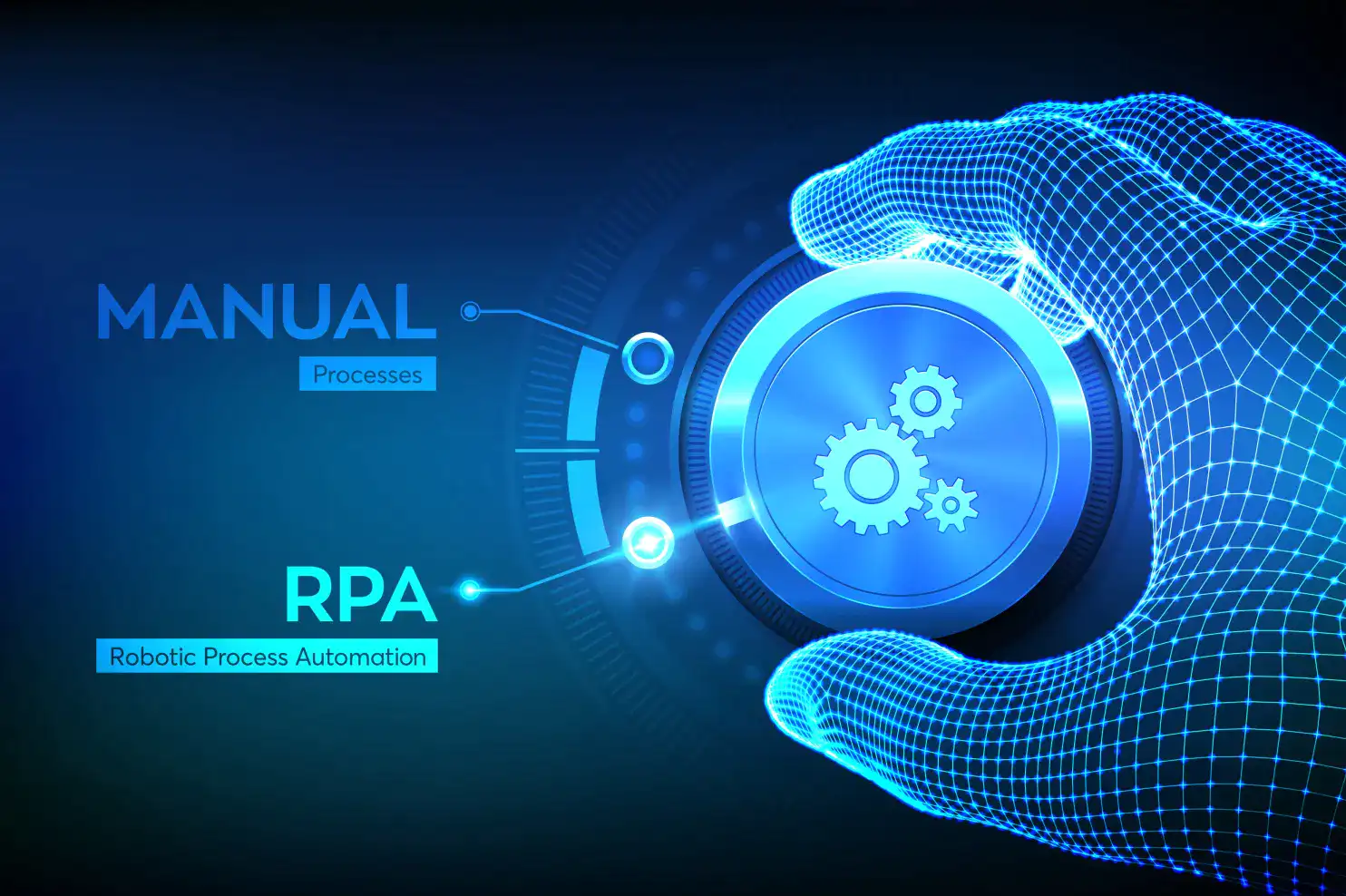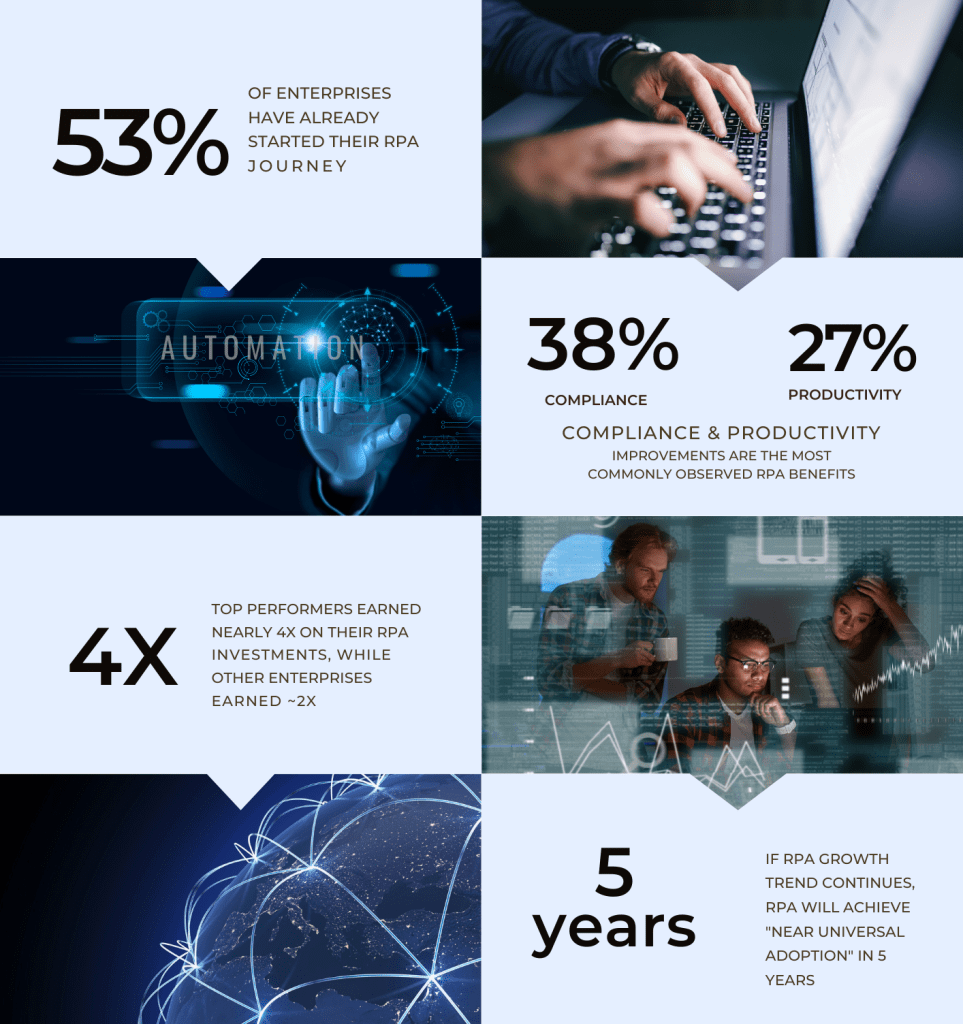Leverage Robotic Process Automation (RPA) Development Services for Scalability
Industry Trends & Innovation
Read Time: 15 mins

Increasingly, investing in Robotic Process Automation is a valuable way to free up your staff to focus on high-value activities: “The more automation there is, the greater the ability for a company to scale.”
If you have your sights set on rapid and sustainable growth, Robotic Process Automation (RPA) development services are the way to go. Thanks to RPA, many modern business processes can now be fully automated, leaving you and your team to focus your attention on core activities that require your full creative energies.
 No wonder the RPA market size is predicted to reach $12 billion by 2025. As newer and better RPA services develop and industries adopt them at increasingly high rates, ignoring their potential means falling behind. Therefore, learning to leverage RPA for your full potential is an absolute must.
If you’re feeling overwhelmed at the prospect, don’t worry. ParallelStaff can help.
In this article, we will:
No wonder the RPA market size is predicted to reach $12 billion by 2025. As newer and better RPA services develop and industries adopt them at increasingly high rates, ignoring their potential means falling behind. Therefore, learning to leverage RPA for your full potential is an absolute must.
If you’re feeling overwhelmed at the prospect, don’t worry. ParallelStaff can help.
In this article, we will:

 No wonder the RPA market size is predicted to reach $12 billion by 2025. As newer and better RPA services develop and industries adopt them at increasingly high rates, ignoring their potential means falling behind. Therefore, learning to leverage RPA for your full potential is an absolute must.
If you’re feeling overwhelmed at the prospect, don’t worry. ParallelStaff can help.
In this article, we will:
No wonder the RPA market size is predicted to reach $12 billion by 2025. As newer and better RPA services develop and industries adopt them at increasingly high rates, ignoring their potential means falling behind. Therefore, learning to leverage RPA for your full potential is an absolute must.
If you’re feeling overwhelmed at the prospect, don’t worry. ParallelStaff can help.
In this article, we will:
- Unpack what Robotic Process Automation (RPA) is and how it can help you scale
- Outline specific ways in which RPA can add value to your business
- Detail what the RPA development process looks like
- Point you to some best practices for leveraging RPA
What Is Robotic Process Automation (RPA)?
Robotic Process Automation (RPA) is an automation solution involving using software bots or artificial intelligence (AI) to increase your efficiency by automating business processes. However, with the advent of generative AI and machine learning (ML), RPA has moved beyond merely automating simple tasks to performing even higher-level functions. Intelligent process automation demands more than the simple rule-based systems of RPA. You can think of RPA as “doing” tasks, while AI and ML encompass more of the “thinking” and "learning," respectively. It trains algorithms using data so that the software can perform tasks in a quicker, more efficient way (IBM). In simple terms, that means the longer you use RPA, the more effective it can become. No wonder RPA is being used across industries. It’s an incredibly versatile and cost-effective business move. Companies currently employ RPA to handle tasks such as- Data entry. Eliminate repetitive, time-consuming tasks related to data entry through process automation.
- Moving files. Scheduling automated file transfers ensures speed and accuracy while reducing workload and eliminating manual effort.
- Extracting data. Scheduling data extraction and automating subsequent data processing allows you to transform unstructured data and access valuable insights seemingly without effort. Access the information you need exactly when you need it.
- Populating forms. No one likes filling out forms. Fortunately, RPA can automate this task for you, freeing you to invest your time and attention in more exciting pursuits.
- Invoice processing. Automating steps in the invoicing process (or the entire process itself) can save you time and money while also reducing the potential for errors and fraud.
- Initiating first steps in customer service. A well-trained RPA bot can engage customers 24/7, answer simple questions, and filter more complicated requests through the appropriate channels so that you only have to weigh in when it’s absolutely necessary.
How RPA Adds Value to Your Business
Investing in RPA development for your business carries measurable benefits.
Reduce Operational Costs
Though there will be costs involved with the initial set-up phases of RPA development, over time, robotic process automation development will reduce your overall operational costs. Because RPA eliminates manual labor associated with many tasks, you will likely experience a significant drop in labor costs.Improve Process Efficiency and Productivity
Companies that automate routine tasks and operations will no longer be asking their employees to expend time, energy, and brainpower on tedious, repetitive tasks. Instead, these tasks seem to take care of themselves, leaving team members to maximize their work hours by focusing on strategic operations.Minimize Human Error
Unattended RPA solutions remove the potential for user errors, seamlessly carrying out scheduled processes right on time.Scale Operations Quickly and Easily
The beauty of RPA solutions is that they can easily be adjusted to scale up and down as needed. Unlike a human staff, which must be hired, fired, and managed, robots and software can simply be reconfigured as needed.Ensure Regulatory Compliance
By automating systems such as permissions, encryption, and data storage and processing, you’re able to ensure that your system is set up to maintain regulatory compliance from start to finish. In these ways and more, organizations that embrace RPA technology can quickly adapt to changing market dynamics and thereby maintain a competitive advantage.4 Steps in the RPA Development Process
If getting started with RPA software development sounds overwhelming, it may be helpful to break the process down into incremental steps.- Step 1: Identify automation opportunities. Not every process can be automated, and even among processes that can, some will offer you a higher ROI than others. In the initial stages, consider meeting with an RPA consultant to narrow down your options.
- Step 2: Design the RPA solution. If you don’t have an RPA developer in house, hire a developer—or a team of developers, depending on the scope of your project—to conduct the actual software development.
- Step 3: Develop and test the bots. Don’t rush the process. Intelligent automation requires a period of testing and training to reach its full potential.
- Step 4: Deploy and maintain your RPA. Once all the kinks have been worked out, you get to sit back and let your RPA software do the heavy lifting for you.
Best Practices to Leverage RPA
Naturally, implementing RPA can come with challenges. In order to make the transition as seamless as possible, implement these eight best practices for leveraging RPA. 8 effective strategies for effective RPA implementation:- Target suitable processes for automation. Rather than simply asking which business process would be easiest to automate, focus on which processes would have the biggest business impact if automated. Again, meeting with an RPA consultant at this stage can prove quite helpful, as they can ask the right questions and offer unique insights.
- Involve stakeholders. Whoever is affected by the RPA project should be informed and involved in the discussion at some level. They may have insights that help with decision-making and implementation.
- Assemble a skilled RPA developer team. Depending on your industry, this may not be something you can do in-house. The good news is that an established RPA development company like ParallelStaff can help you connect with teams of skilled RPA developers ready to take on your project.
- Start with simple processes. Starting small allows you and your team to enjoy some quick wins and give you the confidence to start scaling to bigger processes down the road.
- Ensure compliance and security. Pivots to AI models often come with compliance concerns and security vulnerabilities. Planning compliance and security checks prior to implementation is key.
- Provide employee training. Prior to rollout, employees likely need training in how RPA models work; and depending on their roles, some may even need technical training to maintain and troubleshoot the software.
- Manage change effectively. Involving bots and AI can significantly change how your business operates, and a smooth transition won’t happen by accident. Ensuring that the new process will be embraced by the team will involve intentional RPA training, communication, and support.
- Monitor and optimize continuously. Implementing RPA isn’t a one-and-done procedure. Like any system or process, RPA maintenance is essential to its success. Be sure to factor this into your plan when choosing an RPA implementation service.
